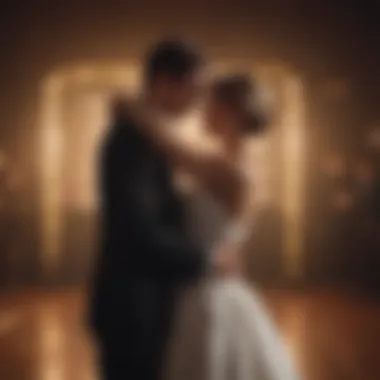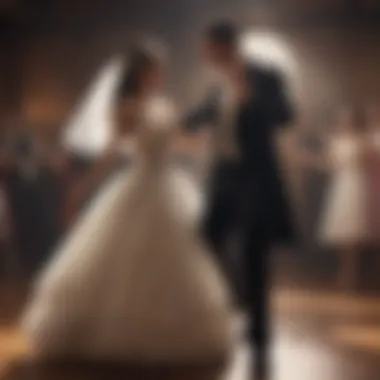Wedding Slow Dance Songs: A Deep Dive into Love's Melodies


Intro
Wedding slow dance songs play a crucial role in creating lasting memories on one’s special day. These songs often encapsulate emotions, making moments shared between couples incredibly meaningful. They stand out by fostering connection and intimacy amidst the festive atmosphere of a wedding. Understanding the themes, influences, and dynamics behind these songs can elevate the overall experience, helping couples make informed decisions tailored to their unique love stories.
This article will explore the emotional significance of these songs, cultural variations, and tips for curating the ideal playlist. The analysis will highlight popular choices along with lesser-known gems, offering a comprehensive guide designed specifically for music enthusiasts, aspiring musicians, and music students.
The journey begins with an examination of artist profiles, focusing on their biographies and influences that ignite the creativity behind wedding slow dance songs.
The Importance of Music in Weddings
Music serves as a cornerstone in the wedding experience, acting as a unifying force that elevates emotional moments. Its role is multifaceted and extends beyond mere background sound. Wedding music shapes the atmosphere, impacts guests' moods, and marks significant milestones throughout the ceremony and reception. The right soundtrack can turn fleeting moments into lasting memories, making the significance of music undeniable.
Psychological Impact of Music
Emotional response to melodies
Melodies have a unique capacity to evoke emotions swiftly and profoundly. Research shows that the human brain responds to music by triggering emotional centers, which explains why certain tunes can instantly elicit happiness, nostalgia, or even sadness. For weddings, slow dance songs play a crucial role in enhancing the emotional depth of the event. The soft harmonies and heartfelt lyrics often resonate deeply with couples and their families.
A key characteristic of these melodies is their ability to create a shared experience. When couples dance to a song that holds particular significance, it serves as a powerful reminder of their bond and their journey together. This emotional connection makes such choices a popular selection in weddings.
However, the emotional response to melodies can have disadvantages as well. If the selected song resonates negatively with someone, it can shift the mood drastically. Care must be taken to ensure that the melody aligns with the overall theme of the event.
Memorable associations and nostalgia
Music often serves as a vessel for memories. Specific songs can transport individuals back to particular moments in time, stirring feelings of nostalgia. This connection is especially relevant in weddings, where songs may remind couples of their first date, engagement, or other meaningful occasions. Choosing slow dance songs that carry personal significance creates a memorable experience that resonates deeply with both the couple and their guests.
Nostalgic music holds a comforting quality—strings of melody can conjure feelings of security and familiarity. This characteristic makes it a beneficial choice for wedding playlists. However, it is essential to be mindful of the emotional weight certain songs might carry; while nostalgia can enhance experiences, it can also evoke challenging memories for some individuals.
Cultural Significance
Tradition and modernity in wedding music
The interplay between tradition and modernity in wedding music is a vital aspect of its significance. Many couples choose to honor long-standing customs by including classic wedding songs, while others may opt for contemporary hits that resonate with their personal style. This duality showcases the evolution of wedding music, reflecting shifts in societal norms and preferences.
A fundamental advantage of traditional wedding songs lies in their established emotional resonance. These pieces often carry rich histories and cultural meanings that elevate the ceremony. On the other hand, modern songs can symbolize new beginnings and shared interests of the couple, making them equally valuable in crafting personal narratives for the day.
Regional variations in slow dance choices
Regional variations in slow dance choices highlight the diversity of wedding music. Different cultures and geographical regions contribute unique flavors that enrich the wedding experience. For example, a Latin American wedding may feature romantic salsa or bachata songs, while a traditional Indian ceremony might incorporate classical pieces with intricate rhythms. These choices reflect the cultural backgrounds and preferences of the couple, making the celebration distinctly personal.
This regional characteristic is beneficial as it introduces a broader array of musical styles and traditions. Furthermore, it invites guests to engage with various cultures, creating a more inclusive atmosphere. However, careful consideration is needed to ensure that the chosen songs resonate well with both the couple and their guests, as regional differences can lead to varying levels of familiarity and comfort.
Defining Slow Dance Songs
Defining slow dance songs is essential in the context of weddings. These songs set the tone for intimate moments. The selection can embody the couple's relationship, bringing together melodies and lyrics that resonate deeply. In this section, we will examine the components that make up the essence of slow dance music, and how these elements contribute to the overall experience of the wedding.


Characteristics of Slow Dance Music
Tempo and rhythm analysis
The tempo of a slow dance song typically ranges between 60 to 80 beats per minute. This slower pace allows for gentle, close movements between partners, enhancing their emotional connection. A key characteristic of this tempo is its ability to facilitate a calming atmosphere. For couples, this can be a beneficial aspect. When the rhythm aligns with a slow, swaying motion, it creates a moment of serenity and romance during the chaos of a wedding.
A unique feature of tempo lies in its impact on feelings. The steady beat resembles a heartbeat, which can evoke a sense of comfort and intimacy. However, it can also be a disadvantage if the tempo is too slow, making the moment feel stagnant.
Lyric themes and emotional resonance
Lyric themes are crucial in establishing a connection and emotional response during slow dances. Songs with heartfelt lyrics often tell a story of love, commitment, or nostalgia, resonating deeply with couples and their guests. This emotional resonance enhances the overall atmosphere, making the slow dance more memorable.
A key characteristic of the lyrics in these songs is their ability to express complex feelings in relatable, simple terms. This makes them an appealing choice, as they can leave a lasting impression on everyone present. However, a disadvantage can arise if the lyrics feel too clichéd or overused, which could lessen their impact.
Genres Influencing Slow Dance Music
Pop and contemporary hits
In recent years, pop and contemporary hits have become significant for weddings. These genres often feature catchy melodies and relatable themes, which attract a wide audience. The use of these modern hits contributes to the overall enjoyment of the event, attracting guests across different age groups.
A notable characteristic of pop music is its production quality. The polished sound can add an entertaining aspect to the wedding experience. Yet, a downside may include the risk of being too mainstream or lacking uniqueness, which some couples may want to avoid on their special day.
Classic ballads and timeless standards
Classic ballads and timeless standards hold a special place in wedding ceremonies. These songs often have rich histories and emotional depths. They can connect generations and evoke strong feelings. The importance of this genre lies in its ability to transcend time and trends, ensuring that the music will always hold a place in people's hearts.
A unique feature of classic ballads is their melodic simplicity. This simplicity can facilitate a more profound emotional experience, often stirring nostalgia. However, relying exclusively on these songs can sometimes lead to a lack of diversity in the playlist, which might not appeal to everyone.
In synthesis, understanding the components of slow dance songs—tempo, musical genres, and lyric themes—offers insights into creating a meaningful atmosphere at weddings. Each of these elements plays a crucial role in ensuring that the moments shared on the dance floor remain memorable.
Popular Wedding Slow Dance Songs
Wedding slow dance songs serve as the heart of many romantic moments during a wedding reception. These songs not only encapsulate the emotional essence of the day but also reflect the couple's unique tastes and shared experiences. The music selected for slow dances can create a lasting memory, enhancing the overall atmosphere of love and celebration. Understanding the popular choices available allows couples to make informed decisions that resonate with their personalities and love stories.
Current Favorites
Trends in recent chart-toppers
Recent chart-toppers often dominate wedding playlists because they resonate with many guests, both young and old. Songs such as "Perfect" by Ed Sheeran and "All of Me" by John Legend have become staples in the wedding scene. This trend emphasizes contemporary love stories, making them relatable for newlyweds. The key characteristic of these songs is their relatable themes about love and commitment. Including them in a wedding playlist provides a feeling of current relevance, connecting couples with their guests through shared musical tastes. The unique feature of chart-toppers is their production quality and catchy melodies, making them appealing to a broad audience. However, not every couple may connect deeply with mainstream hits, which could lead to a more generic experience for some.
Analysis of lyrics and themes
The lyrics and themes of current favorites often revolve around love, unity, and shared dreams. The simplicity and emotional weight of the words enhance their appeal. Analyzing lyrics provides insight into how the couple identifies with the song, creating a more personal connection. This connection is crucial when choosing a slow dance song because it sets the emotional tone for the moment.
Songs like "Say You Won't Let Go" by James Arthur exemplify relatable storytelling, drawing listeners into intimate narratives. However, there can be a downside; the prevalence of these songs can sometimes diminish their uniqueness for couples who desire something more individualized for their special day.


Timeless Classics
Iconic songs from past decades
Timeless classics are crucial for many wedding playlists, providing a sense of nostalgia and familiarity. Songs like "Wonderful Tonight" by Eric Clapton or "At Last" by Etta James have endured through generations. Their key characteristic is their emotional depth, often drawing tears and smiles from those who hear them. This emotional readiness makes these songs an excellent choice for couples who wish to evoke strong feelings among their guests. The unique feature of these timeless tracks is their ageless themes of love and commitment, which resonate across different demographics. Their main advantage is their ability to create a nostalgic atmosphere, though they may feel less fresh compared to more modern selections.
Why they remain popular today
Timeless classics remain popular today due to their relatable lyrics and the emotional resonance they offer. These tracks have a unique ability to transcend trends, touching on universal themes of love and family. For many couples, these songs hold personal significance, reminding them of special moments in their relationship. The timeless quality ensures that they can connect with older and younger generations, making them a beneficial choice for any wedding. One advantage of including these songs is that they create a rich tapestry of music that can bring diverse family members together, despite differences in personal taste. However, their popularity may lead to overuse, leaving couples in search of something unique feel pressured to find alternatives.
Lesser-Known Yet Meaningful Songs
The exploration of lesser-known yet meaningful songs plays an essential role in understanding the broader landscape of wedding music. These tracks often provide a fresh alternative to the mainstream selections that dominate playlists. Couples looking for something distinctive may turn to these songs to create a unique experience on their special day. By incorporating lesser-known songs, they can express their personal story and emotional depth beyond the familiar hits. Additionally, these tracks often allow for more intentional and selective curation, resulting in a playlist that resonates on a deeper level.
Hidden Gems for the Discerning Couple
Exploring indie artists and niche tracks
The focus on indie artists and niche tracks contributes greatly to the conversation around lesser-known slow dance songs. These artists often produce music that, while not widely recognized, captures profound emotions and personal stories. The beauty of choosing such songs is that they can speak to the couple's journey, offering a more intimate connection than popular tracks. Indie songs tend to emphasize originality and artistry, which can elevate a wedding experience to something more memorable. However, one should be aware that these tracks may not have the same universal appeal as classic hits, potentially leaving some guests unfamiliar with the music.
Unique emotional depth in lesser-known songs
The unique emotional depth found in lesser-known songs often offers a raw and authentic portrayal of love. This characteristic makes them a considerable choice for wedding playlists. These songs can convey feelings that might resonate with the couple’s journey or sentiments in a way that mainstream tracks might not. In less commercialized music, there may be a sense of vulnerability in the lyrics that enhances the emotional atmosphere of a wedding. On the downside, the obscurity of these tracks may require a more attentive audience to fully appreciate their essence, which could detract from the overall ambiance.
Culturally Diverse Selections
Highlighting international artists
The inclusion of international artists broadens the spectrum of possibilities for wedding slow dances. These artists bring unique sounds, styles, and cultural influences that can enrich the overall experience. They often incorporate traditional instruments or regional styles that may evoke a shared cultural heritage among guests or serve as a homage to the couple’s backgrounds. This layer of meaning may make the event feel more representative of the couple's identity. However, careful selection is crucial as some guests may find it challenging to connect with unfamiliar musical forms.
Songs that reflect cultural traditions
Choosing songs that reflect cultural traditions highlights an important aspect of diverse wedding celebrations. This can breathe life into the event and solidify the couple's roots. These tracks often tell stories or express sentiments that have been passed down through generations. Understanding the significance of these songs can enhance the emotional weight of the dance, making it a pivotal moment for the couple and their families. However, not all songs are universally recognized, and this may lead to potential disconnects among guests who are unfamiliar with the cultural context.
Crafting the Ideal Playlist
Creating an ideal playlist for a wedding slow dance is essential for setting the tone of the event. A well-curated selection of songs has the power to evoke emotions and memories, enhancing the couple's experience. This section explores various elements that contribute to an effective playlist, highlighting the importance of considering guest preferences and the flow of the event.
Factors to Consider
Guest preferences and demographics
Understanding guest preferences plays a significant role in crafting the ideal playlist. Different generations may have distinct musical tastes, which impacts how songs are received during the wedding. For example, older guests may appreciate classic love songs, while younger attendees might lean towards contemporary pop hits. The key characteristic of knowing the audience is to create an inclusive atmosphere that resonates with everyone present.
The unique feature of this approach is that it encourages couples to gather input from their family and friends. This not only results in a diverse playlist but also ensures that guests feel involved in the celebration. However, balancing differing tastes can be challenging, and songs that appeal to one group may not resonate with another.


Flow and dynamics of the event
Flow and dynamics are crucial when selecting songs for a wedding. Transitioning smoothly from one song to another can maintain energy levels and keep the mood consistent throughout the event. A well-thought-out playlist allows for quieter, slower songs during intimate moments, such as the first dance, followed by more upbeat tracks as the evening progresses.
The key characteristic here is the ability to read a room. An effective playlist should adapt to guest reactions. The unique feature of this dynamic adjustment is that it can enhance the overall experience. However, it is important to plan ahead, as spontaneous changes on the fly may not always align with the couple's vision.
Balancing Tradition and Personal Taste
Incorporating personal favorites
Incorporating personal favorites into the wedding playlist can deeply enrich the overall experience. Each couple will have songs that hold special meaning, perhaps connected to their relationship milestones or shared experiences. These personal selections add authenticity and personality to the celebration.
The advantage of this approach is that it creates unique and memorable moments. However, there can be a challenge in blending these personal choices with more commonly accepted wedding songs. A thoughtful balance ensures that the playlist diversity remains engaging without losing the couple's touch.
Maintaining a cohesive thematic experience
Maintaining a cohesive thematic experience throughout the playlist can elevate the emotional impact of the evening. A consistent theme, whether it is romantic ballads, nostalgic hits, or contemporary love songs, can connect different segments of the event.
The key aspect of a cohesive playlist is to create a narrative flow that reflects the couple's relationship journey. This approach enables guests to experience the music as part of a larger story. However, there can be limitations to this method if personal favorites do not align with the chosen theme. Careful curation can resolve these issues, maintaining continuity while honoring the couple's choice.
In summation, crafting an ideal playlist for wedding slow dances involves a mix of understanding guest preferences, maintaining flow, incorporating personal favorites, and ensuring thematic coherence. This blend ultimately creates a memorable and emotional experience for everyone involved.
The Role of a DJ or Live Band
Choosing the right music provider plays a central role in setting the tone for a wedding. The right choice can enhance emotional experiences and create lasting memories. A DJ or live band brings their own unique advantages and considerations that need careful evaluation. Understanding these can greatly influence the atmosphere of the event and the overall enjoyment of the guests.
Choosing Between DJ and Live Music
Pros and cons of each option
When couples are deciding between hiring a DJ or a live band, it is important to weigh the pros and cons of both options. A DJ generally offers a larger variety of music selections. They can mix different genres seamlessly, providing a continuous flow of music which can cater to diverse tastes. On the other hand, a live band brings an element of spontaneity and can engage with the audience more directly. Their performance can make significant moments, like the couple's first dance, feel more special.
However, there are drawbacks. A DJ may lack the personal connection that a live band provides, making it feel less intimate. Live bands, while providing a unique experience, often have a limited playlist and may not be able to fit all requested songs on short notice. Couples should think about these aspects when making their choice.
Impact on the overall atmosphere
The impact that the choice of DJ or live band can have on the overall atmosphere of the wedding cannot be overstated. DJs can create a lively ambiance, adjusting the tempo and genre based on the crowd’s reactions. This adaptability is one reason why many couples choose DJs. They can pivot between music styles to keep everyone engaged.
Conversely, a live band has the ability to create a unique atmosphere that feels authentic. Their interaction with the audience helps to build a sense of community among guests. Live performances can infuse energy into the event but might also require careful selection of songs to maintain the desired mood.
Communication with Music Providers
Effective communication with music providers is essential to achieving a successful musical experience on the wedding day. A clear discussion can help ensure that the chosen songs fit the couple’s vision and the overall vibe they want to create.
Discussing song selections
Engaging in open dialogue about song selections can greatly enhance the musical component of the wedding. Couples should articulate their preferences and must-include songs, as well as any genres or specific artists they favor. This ensures their vision is honored while also allowing the music provider to contribute their expertise. A good understanding of the couple's preferences can significantly improve the experience.
Creating a seamless experience
Creating a seamless experience is vital for ensuring the event flows smoothly. A well-established communication channel helps manage transitions between different segments of the wedding. For instance, ensuring that the first dance song is well-timed or that songs chosen for special moments are ready to go can greatly reduce stress. Moreover, the ability to communicate logistics, such as setup needs and timing, helps avoid potential hiccups, which can distract from the celebration.
In summary, the interplay between music providers and the couple’s vision is pivotal for a successful wedding. Whether it is choosing between a DJ or a live band or discussing specific song selections, clarity and openness are crucial to attaining the desired atmosphere and ensuring a memorable celebration.







